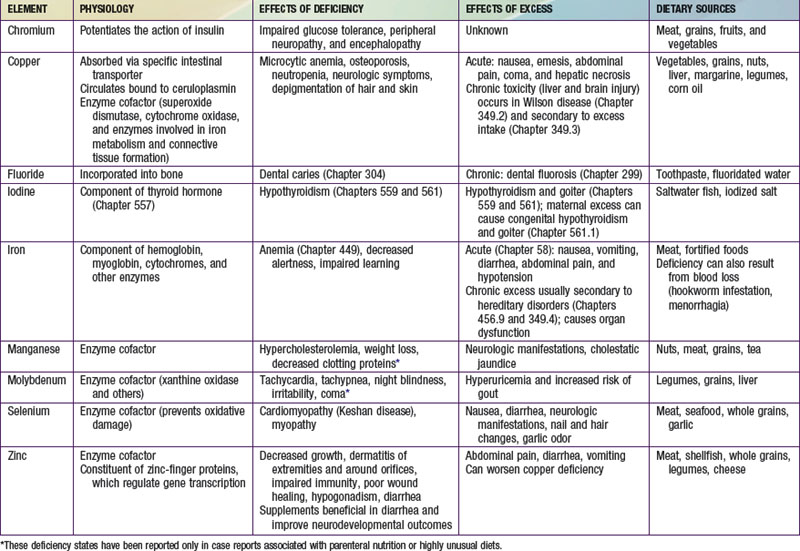Chapter 51 Micronutrient Mineral Deficiencies
Micronutrients include vitamins (![]() Chapters 45–50) and trace elements. By definition, a trace element is <0.01% of the body weight. Trace elements have a variety of essential functions (see Table 51-1 on the Nelson Textbook of Pediatrics website at www.expertconsult.com). With the exception of iron deficiency, trace element deficiency (see Table 51-1) is uncommon in developed countries, but some deficiencies (iodine, zinc, selenium) are important public health problems in a number of developing countries. Because of low nutritional requirements and plentiful supply, deficiencies of some of the trace elements are extremely rare in humans and typically occur in patients receiving unusual diets or prolonged total parenteral nutrition without adequate delivery of a specific trace element. They can also occur in children with short bowel or malabsorption. Excess intake of trace elements (see Table 51-1) is uncommon, but it can result from environmental exposure or overuse of supplements.
Chapters 45–50) and trace elements. By definition, a trace element is <0.01% of the body weight. Trace elements have a variety of essential functions (see Table 51-1 on the Nelson Textbook of Pediatrics website at www.expertconsult.com). With the exception of iron deficiency, trace element deficiency (see Table 51-1) is uncommon in developed countries, but some deficiencies (iodine, zinc, selenium) are important public health problems in a number of developing countries. Because of low nutritional requirements and plentiful supply, deficiencies of some of the trace elements are extremely rare in humans and typically occur in patients receiving unusual diets or prolonged total parenteral nutrition without adequate delivery of a specific trace element. They can also occur in children with short bowel or malabsorption. Excess intake of trace elements (see Table 51-1) is uncommon, but it can result from environmental exposure or overuse of supplements.
The consequences of severe isolated trace mineral deficiency are illustrated in certain genetic disorders. The manifestations of Menkes disease (Chapter 592) are due to a mutation in the gene coding for a protein that facilitates intestinal copper absorption. This mutation results in severe copper deficiency; subcutaneous copper is an effective treatment. The recessive disorder acrodermatitis enteropathica (Chapter 663) is secondary to malabsorption of zinc. These patients respond dramatically to zinc supplementation.
Aggarwal R, Sentz J, Miller MA. Role of zinc administration in prevention of childhood diarrhea and respiratory illnesses: a meta-analysis. Pediatrics. 2007;119:1120-1130.
Alexander J. Selenium. Novartis Found Symp. 2007;282:143-149.
Bhandari N, Mazumder S, Taneja S, et al. Effectiveness of zinc supplementation plus oral rehydration salts compared with oral rehydration salts alone as a treatment for acute diarrhea in a primary care setting: a cluster randomized trial. Pediatrics. 2008;121:e1279-e1285.
Bhatnagar S. Effects of zinc supplementation on child mortality. Lancet. 2007;369:885-886.
Bhutta ZA. Childhood iron and zinc deficiency in resource poor countries. BMJ. 2007;334:104-105.
Boldery R, Fielding G, Rafter T, et al. Nutritional deficiency of selenium secondary to weight loss (bariatric) surgery associated with life-threatening cardiomyopathy. Heart Lung Circ. 2007;16:123-126.
Dinulos JG, Zembowicz A. Case records of the Massachusetts General Hospital. Case 32–2008. A 10-year-old girl with recurrent oral lesions and cutaneous bullae. N Engl J Med. 2008;359:1718-1724.
Erikson KM, Thompson K, Aschner J, et al. Manganese neurotoxicity: a focus on the neonate. Pharmacol Ther. 2007;113:369-377.
Geltman PL, Hironaka LK, Mehta SD, et al. Iron supplementation of low-income infants: A randomized clinical trial of adherence with ferrous fumarate sprinkles versus ferrous sulfate drops. J Pediatr. 2009;154:738-743.
Kumar N. Copper deficiency myelopathy (human swayback). Mayo Clin Proc. 2006;81:1371-1384.
Lukacik M, Thomas RL, Aranda JV. A meta-analysis of the effects of oral zinc in the treatment of acute and persistent diarrhea. Pediatrics. 2008;121:326-336.
Naismith RT, Shepherd JB, Weihl CC, et al. Acute and bilateral blindness due to optic neuropathy associated with copper deficiency. Arch Neurol. 2009;66:1025-1027.
Zimmermann MB. Iodine deficiency in pregnancy and the effects of maternal iodine supplementation on the offspring: a review. Am J Clin Nutr. 2009;89:668S-672S.
Zimmermann MB, Jooste PL, Pandav CS. Iodine-deficiency disorders. Lancet. 2008;372:1251-1262.






